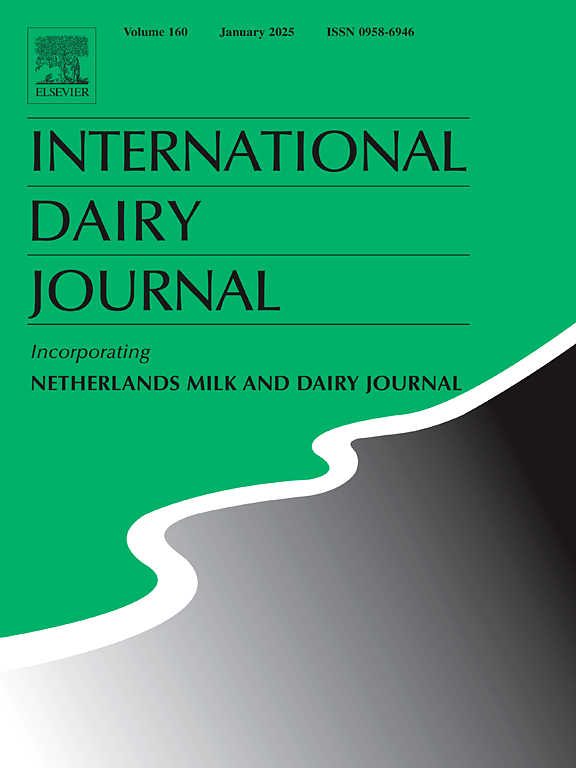α-乳蛋白与天然或热变性乳铁蛋白之间的自发相互作用
IF 3.1
3区 农林科学
Q2 FOOD SCIENCE & TECHNOLOGY
引用次数: 0
摘要
在pH 5.0 ~ 7.0时,天然乳铁蛋白在一定的混合比例下与α-乳清蛋白弱相互作用。对于变性乳铁蛋白和天然α-乳清蛋白,在较宽的混合比例下观察到较高的浊度。当α-乳白蛋白/乳铁蛋白比例高时,zeta电位为负,当乳铁蛋白/α-乳白蛋白比例高时,zeta电位为正,当混合比例一定时,zeta电位为零。随着pH值的增加,这个等电点转移到更高的乳铁蛋白/α-乳白蛋白比率。未加热乳铁蛋白/ α-乳白蛋白混浊物组成无法确定;然而,对于加热后的乳铁蛋白/未加热的α-乳白蛋白,颗粒材料的组成表明,并不是所有的乳铁蛋白或α-乳白蛋白都在配合物中,除了pH为5.0的样品外,配合物中乳铁蛋白/α-乳白蛋白的比例高于原始样品。需要进一步的研究来阐明所形成的配合物的潜在应用。本文章由计算机程序翻译,如有差异,请以英文原文为准。
Spontaneous interactions between α-lactalbumin and native or heat-denatured lactoferrin
At pH 5.0 to 7.0, native lactoferrin weakly interacts with α-lactalbumin at certain mixing ratios. For denatured lactoferrin and native α-lactalbumin a higher turbidity is observed over a wide mixing ratio. The zeta potential is negative at high α-lactalbumin/lactoferrin ratios and positive at high lactoferrin/α-lactalbumin ratios, with a zero zeta potential at a certain mixing ratio the zeta potential. This isoelectric point shifted to higher lactoferrin/α-lactalbumin ratios as the pH increased. The composition of the turbid material for the unheated lactoferrin/unheated α-lactalbumin samples could not be determined; however, for the heated lactoferrin/unheated α-lactalbumin, the composition of the pelleted material indicated that not all the lactoferrin or α-lactalbumin was in the complexes, and, except for the sample at pH 5.0, the lactoferrin/α-lactalbumin ratio in the complexes was higher than that in the original samples. Further studies are required to elucidate the potential applications of the complexes formed.
求助全文
通过发布文献求助,成功后即可免费获取论文全文。
去求助
来源期刊

International Dairy Journal
工程技术-食品科技
CiteScore
6.50
自引率
9.70%
发文量
200
审稿时长
49 days
期刊介绍:
The International Dairy Journal publishes significant advancements in dairy science and technology in the form of research articles and critical reviews that are of relevance to the broader international dairy community. Within this scope, research on the science and technology of milk and dairy products and the nutritional and health aspects of dairy foods are included; the journal pays particular attention to applied research and its interface with the dairy industry.
The journal''s coverage includes the following, where directly applicable to dairy science and technology:
• Chemistry and physico-chemical properties of milk constituents
• Microbiology, food safety, enzymology, biotechnology
• Processing and engineering
• Emulsion science, food structure, and texture
• Raw material quality and effect on relevant products
• Flavour and off-flavour development
• Technological functionality and applications of dairy ingredients
• Sensory and consumer sciences
• Nutrition and substantiation of human health implications of milk components or dairy products
International Dairy Journal does not publish papers related to milk production, animal health and other aspects of on-farm milk production unless there is a clear relationship to dairy technology, human health or final product quality.
 求助内容:
求助内容: 应助结果提醒方式:
应助结果提醒方式:


